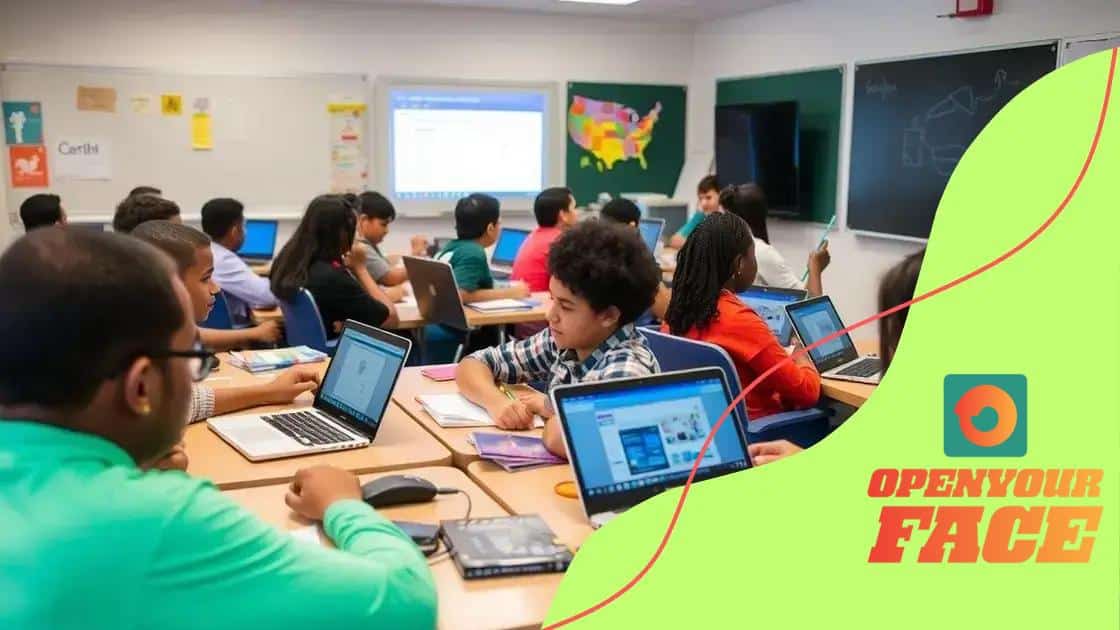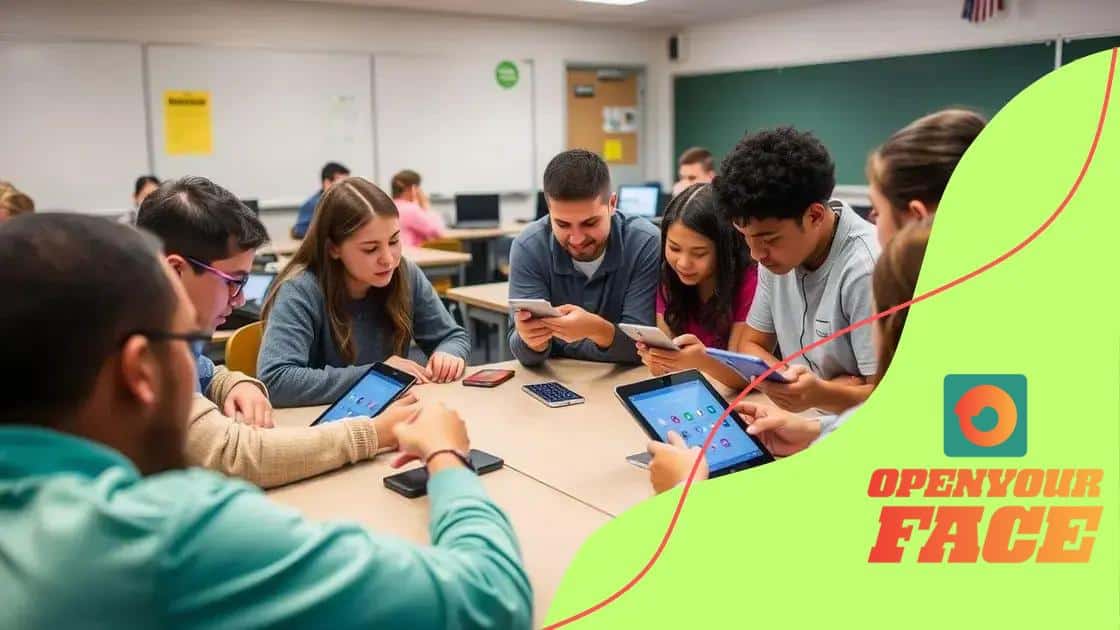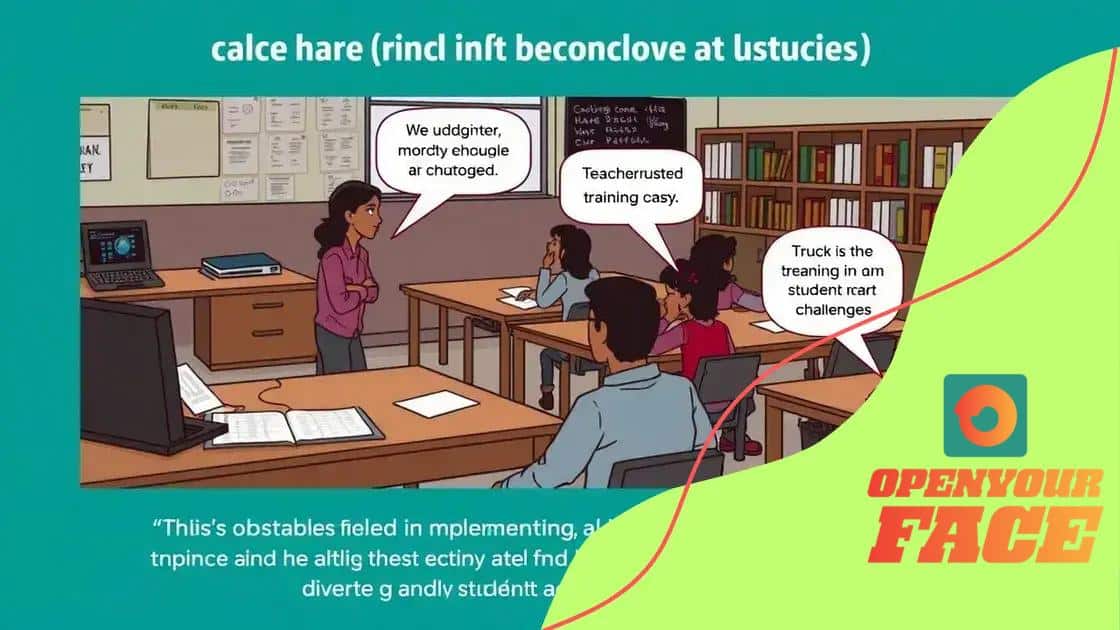How digital literacy programs are evolving in schools

Digital literacy programs in schools focus on teaching essential skills such as coding, digital citizenship, and critical thinking to prepare students for a technology-driven future.
How digital literacy programs are evolving in schools is an exciting trend that impacts students’ learning experiences daily. Have you ever considered how these programs equip our kids for the future?
Understanding digital literacy in education
Understanding digital literacy in education is becoming essential as technology advances rapidly. Schools are adapting to the changing landscape, ensuring that students are not just consumers of technology but also proficient users. By incorporating digital literacy programs, educators are preparing students for a tech-driven world.
What is Digital Literacy?
Digital literacy involves the ability to find, evaluate, create, and communicate information using digital technologies. It is more than just knowing how to use a computer; it includes understanding how to use technology thoughtfully and responsibly.
Importance of Digital Literacy in Education
With the increasing prevalence of technology in our daily lives, teaching digital literacy has become a priority in education. Here are some reasons why:
- Enhances critical thinking and problem-solving skills
- Prepares students for future job markets
- Encourages responsible online behavior
- Facilitates collaboration and communication
As students engage with various digital tools, they develop a strong foundation that supports their learning across all subjects. Educators play a vital role by integrating digital literacy into the curriculum, making it a seamless part of the learning process.
Moreover, by fostering a digital literacy mindset, students learn to navigate complex information and differentiate between credible sources and misinformation. This skill is crucial in an age where information is abundant yet can often be misleading.
Implementing Digital Literacy Programs
Schools can implement various methods to boost digital literacy. Professional development for teachers is key, as they need the skills to guide their students effectively. Collaboration with technology specialists can enhance teachers’ knowledge and provide students with hands-on experiences.
Incorporating project-based learning can also provide students with opportunities to apply their knowledge in real-world situations. This approach not only makes learning more engaging but also solidifies digital literacy concepts through practical application.
As we continue to explore the impact of digital tools, it becomes clear that a strong emphasis on digital literacy in schools is essential. By preparing students with these vital skills, we set them up for success in their academic and professional futures.
Key benefits of digital literacy programs

The key benefits of digital literacy programs in schools are numerous, impacting students and educators alike. As technology continues to shape our society, equipping students with essential digital skills is crucial for their future.
Enhancing Critical Thinking Skills
Strong digital literacy enhances critical thinking abilities. Students learn to analyze information critically, distinguishing between reliable and unreliable sources. This skill is vital for navigating the vast amounts of information available online.
Preparing for Future Careers
Another significant benefit is that these programs prepare students for future careers. Many jobs today require a solid understanding of technology. By integrating digital literacy into the curriculum, schools provide students with a competitive edge in the job market.
- Students become familiar with industry-standard software.
- They develop collaboration and communication skills through tech-based projects.
- Students are more adaptable to new technologies.
Furthermore, as technology evolves, so does the job landscape. Programs that emphasize digital literacy help students adapt to these changes, ensuring they remain relevant in their chosen fields.
In addition, digital literacy programs foster creativity and innovation. With the right tools, students can express themselves in new ways, whether through creating digital art, coding, or designing websites. This creative outlet is essential in encouraging a love for learning.
Improving Digital Citizenship
Another major advantage is the emphasis on responsible digital citizenship. Students learn how to behave appropriately online, respect others’ rights, and understand the implications of their digital footprints. By fostering a sense of digital responsibility, schools create informed citizens.
This awareness extends to understanding privacy settings, recognizing cyberbullying, and promoting positive online interactions. Highlighting digital citizenship ensures students not only use technology effectively but also ethically.
As we progress into a more digitized world, the benefits of digital literacy programs become increasingly clear. Not only do they equip students with essential skills, but they also empower them to navigate and lead in a technology-driven future.
Innovative approaches to teaching digital skills
Innovative approaches to teaching digital skills are transforming how educators engage with students. As technology continues to advance, it is vital for schools to adopt new methods to ensure that learners are equipped for the future.
Project-Based Learning
One effective method is project-based learning. This approach allows students to work on real-world projects that require critical thinking and creativity. When students participate in meaningful projects, they can apply digital skills in practical scenarios.
- Students collaborate with peers, enhancing teamwork skills.
- They use various technologies to complete tasks.
- Real-world applications engage students and make learning relevant.
Another innovative strategy involves gamification. By introducing game elements into lessons, educators make learning fun and interactive. Students often respond positively to challenges and rewards, which can lead to greater retention of digital skills.
For example, creating quizzes or interactive activities can motivate students to engage deeply with the material. This method helps them master concepts while enjoying the learning process.
Flipped Classroom Model
The flipped classroom model is gaining popularity as well. In this model, students learn new content at home through videos or online resources and apply what they learned during class time. This approach allows teachers to focus on hands-on activities that further develop digital skills.
By having access to instructional content outside of class, students can learn at their own pace. They can revisit challenging topics before engaging in collaborative work during school hours. This method encourages deeper understanding and application of digital skills.
Integrating coding into the curriculum is another innovative approach. Teaching students to code not only introduces them to programming but also enhances their problem-solving abilities. Many schools are now including coding workshops or clubs to spark interest among students.
Encouraging students to create their own websites or apps can empower them. This hands-on experience builds confidence and fosters entrepreneurial thinking while reinforcing essential digital skills.
Overall, innovative teaching methods are crucial in developing digital skills that students will use throughout their lives. By fostering creativity, collaboration, and critical thinking in digital contexts, educators prepare students to thrive in a rapidly changing world.
Challenges in implementing digital literacy initiatives

Challenges in implementing digital literacy initiatives are significant but essential to understand. As schools strive to prepare students for a technology-driven world, they face various obstacles that can hinder progress.
Funding and Resources
One of the primary challenges is securing adequate funding and resources. Many schools operate on tight budgets, making it difficult to invest in new technology or training programs. Without the proper tools and resources, teaching digital literacy effectively becomes a struggle.
- Schools may lack modern devices for students.
- Professional development for teachers can be limited.
- Access to quality educational materials might be restricted.
Additionally, rural and low-income areas often have fewer resources, which can widen the digital divide among students.
Teacher Training
Another challenge lies in teacher training. Many educators feel unprepared to teach digital literacy, particularly if they have not received adequate training themselves. Ensuring teachers are comfortable and knowledgeable with digital tools is crucial.
When educators lack confidence in using technology, it can negatively affect their ability to teach these skills. Ongoing professional development opportunities are essential to help teachers stay current and effectively educate students.
Moreover, some educators may resist changing traditional teaching methods. Embracing new technologies requires a shift in mindset, which can sometimes be met with reluctance.
Curriculum Integration
Integrating digital literacy into existing curricula can also be challenging. Many subjects already have the focus, and finding ways to embed digital skills without overwhelming students or teachers can be tricky.
Additionally, aligning digital literacy with state standards and assessments might complicate implementation. Schools need to ensure that these initiatives complement educational objectives without detracting from core subjects.
Lastly, ensuring equitable access to technology for all students remains a pressing challenge. Disparities in access can lead to unequal learning opportunities, further exacerbating existing inequalities in education.
To successfully implement digital literacy initiatives, schools must confront these challenges head-on. By working together to secure funding, provide training, and integrate technology into curricula, educators can better prepare students for a digital future.
Future trends in digital literacy education
Future trends in digital literacy education are crucial for shaping how students learn and interact with technology. As we look ahead, several emerging trends highlight the importance of adapting teaching practices to meet the demands of a changing world.
Increased Focus on Coding and Computational Thinking
One significant trend is the increased emphasis on coding and computational thinking within the curriculum. As technology continues to evolve, understanding the principles behind coding is becoming essential. Schools are starting to incorporate coding classes from an early age, allowing students to develop a strong foundation in these skills.
- Students learn to solve problems systematically.
- They develop logical thinking and creativity through coding projects.
- Programming languages are becoming part of regular education.
This trend not only equips students with valuable skills but also encourages a mindset of innovation, which is essential for the future job market.
Integration of Artificial Intelligence and Technology
The integration of artificial intelligence (AI) and technology in education is another key trend. Schools are exploring how AI can personalize learning experiences. By using data to adapt lessons to meet individual students’ needs, educators can provide tailored instruction.
AI-driven tools can assist in identifying students’ strengths and weaknesses, allowing for targeted support. Furthermore, technology is becoming increasingly immersive, with the use of virtual and augmented reality enhancing digital literacy lessons. These tools provide engaging and interactive experiences that capture students’ attention.
Additionally, there is a push for a blended learning model that combines traditional teaching methods with digital resources. This approach allows for greater flexibility and accessibility, adapting to various learning styles.
Emphasis on Digital Citizenship and Online Safety
As more aspects of life become digital, educating students about digital citizenship is becoming essential. Teaching digital literacy now includes a focus on online safety, ethics, and responsible use of technology.
Students learn how to navigate the internet safely, recognize misinformation, and understand the importance of protecting their personal information. Incorporating lessons on digital footprints and online behavior is essential for developing responsible digital citizens.
Encouraging critical thinking about the information they consume and share develops responsible online behavior. As awareness of cyberbullying and online aggression rises, integrating discussions about these topics into lessons is vital.
In summary, the future of digital literacy education lies in emphasizing coding, leveraging technology, and fostering responsible digital citizenship. By aligning educational practices with upcoming trends, schools can better prepare students for a dynamic and ever-changing technological landscape.
In conclusion, the evolution of digital literacy programs in schools is vital for preparing students for the technology-driven future. By focusing on innovative teaching methods, addressing challenges, and embracing future trends, educators can equip students with the skills needed to navigate the digital world responsibly and effectively. As these programs continue to develop, they will play an essential role in fostering critical thinking, creativity, and digital citizenship among students, helping them thrive in an increasingly complex and interconnected society.
FAQ – Frequently Asked Questions About Digital Literacy in Education
Why is digital literacy important for students?
Digital literacy is crucial as it prepares students for a technology-driven future, equipping them with the skills needed to navigate and succeed in our digital world.
What are some innovative methods for teaching digital skills?
Innovative methods include project-based learning, coding classes, and gamification, all of which engage students and enhance their understanding of digital tools.
What challenges do schools face in implementing digital literacy programs?
Schools often face challenges like limited funding, lack of resources, and the need for teacher training, which can hinder the effective implementation of digital literacy initiatives.
What future trends are emerging in digital literacy education?
Future trends include a greater emphasis on coding, the integration of AI in learning, and a focus on digital citizenship to promote responsible technology use among students.






